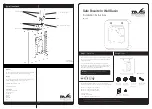
E
n
g
lis
h
E
n
g
lis
h
6
7
Securing instructions
Anchoring option is for Secure Doc Executive only
(not applicable for Secure Disc)
Recommendation
We recommend that you:
• Position the safe as near to the floor as
possible in case of outbreak of fire.
• Secure your safe with the anchoring bolt
provided to the floor. This offers the best
protection against unauthorised removal of
your safe.
Your safe is equipped with one hole in the bottom.
Using the fixing set supplied, you can secure the
safe to the floor. For details, see figure 1.
If you wish to install it on a wooden floor it may be
desirable to use different fixings to ensure optimum
fixing strength. Various types of anchor bolts are
available for use in wood which can give a better
result that the screws supplied. The choice of
fixings is largely determined by the thickness and
type of wood on which the safe is placed.
What do you need?
To secure the safe you need fixings and tools.
Before starting to secure the safe, check that you
have the following items to hand:
1. The fixing set supplied.
2. An electric (hammer) drill. If the base material
is concrete, you will need a hammer drill.
3. The fixing hole in the base material needs to
be drilled first. If the base material is concrete
or stone, you will need a concrete drill bit. If the
base material is wood, use wood drill bit. Note:
you may therefore require both drill bits, for
example if the floor is made of concrete and
the wall is wood.
4. A socket wrench.
5. A vacuum cleaner to clear the drill holes.
6. Possibly a hammer.
Installation instructions
1. Place the safe in the position you have
selected. Before marking or drilling any holes
ensure that there are no pipes or cables
present at the fixing points. If there is skirting
board present at the desired fixing point, this
should be removed to allow the safe to be
fitted flush to the wall.
2. Open the safe and remove any shelves and /
or trays.
3. Remove the metal cover with a screwdriver to
gain access to the anchoring hole.
4. Using a pencil or a sharp object, mark out the
drill hole.
5. Close the safe.
6. Now move the safe to give enough room to
drill the fixing hole.
7. Drill the hole: you will need the concrete drill bit
for a concrete base material, and the wood drill
bit for a wooden base material.
8. Clear the drill hole and remove any drilling
debris using a vacuum cleaner.
9. If you have drilled hole in a concrete floor,
ensure that the end of the plug is level with the
edge of the drill hole. If necessary, use a
hammer to insert the plug. The plugs are not
used when securing the safe to a wooden
floor.
10.Now position the safe so that the fixing holes
on safe match the drill holes in the floor.
11.Secure the safe using the fixing screws
supplied. Slide the washer over the fixing
screw before screwing it into the drill hole. You
will need a socket wrench to drive in the screw.
12.You can cover the hole again with the metal
cover.
Maintenance
• Never throw your keys. Distortion of the key
can damage the lock.
• When closing the door, there should never be
anything between the door and the safe (e.g. a
paper clip). The bolts must be fully retracted.
• Do not fill the safe to such an extent that it is
hard to close the door. The locking mechanism
could then seize up as a result of pressure on
the inner plate.
• Ensure that the key in the door does not hit a
wall when opening. This can cause the key to
snap, and can damage the locking
mechanism.
• If you find that the lock becomes harder to
open or stiffer, never use oil or graphite
powder to “lubricate” the lock. This can make
the tumblers sticky, which could prevent the
lock from opening at all. Your supplier can
advise you on the correct cleaning product to
use.
• The outside of your safe can be cleaned with a
slightly damp cloth. Never use chemical
cleaning agents.
Troubleshooting
Although your safe has been manufactured with
the greatest care, a fault may nevertheless occur,
such as:
• The locking mechanism does not work
• You cannot open your safe
• Faulty lock
• You lose your key
The most important rule is not to try and force
anything. The locking mechanism in particular
is made of precision components which can be
damaged.
First re-read the manual. If you cannot find a
solution, contact your supplier.
Figure 1
























